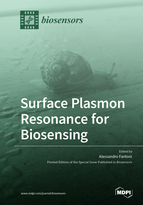Surface Plasmon Resonance for Biosensing
A special issue of Biosensors (ISSN 2079-6374). This special issue belongs to the section "Biosensor and Bioelectronic Devices".
Deadline for manuscript submissions: closed (28 February 2022) | Viewed by 41517
Special Issue Editor
2. Instituto Superior de Engenharia de Lisboa (ISEL), R. Conselheiro Emídio Navarro 1, 1959-007 Lisboa, Portugal
Interests: photonic devices; semiconductor science; biomedical sensors
Special Issue Information
Dear Colleagues,
Point-of-care (POC) methods for medical screening and timely disease diagnosis, allowing a continuous general health state assessment, are central for the future development of health systems. From this point of view, biosensors based on surface plasmon resonance (SPR) effects can play a major role because of their high sensitivity, reduced fabrication process complexity, and high level of integration. They offer the potential to move proteomic biology into the clinical setting as a routine diagnostic procedure and surpass the technical challenge of conventional methods. The light-generated SPR phenomena depend on the fine-tuning of the wavelength against the geometry of the resonant structures and the optical properties of the materials that are used. Targeting the optimization of this key point, a large panorama of different structure configurations can be proposed, based on different schemes for plasmon generation and sensor interrogation methods, ranging from local nanoparticle response (LSPR), optical waveguides, optical fibers, and interferometers, to advanced structures where the SPR is enhanced by the mutual influence of different nanostructures with 2D materials. The overall performance of the resulting biosensor depends on the ability to immobilize specific antibodies while maintaining their biological activity, as well as providing antibodies accessibility to the analyte.
Surface Plasmon Resonance for Biosensing is a very interdisciplinary research playground and this Special Issue will serve as a vehicle for the dissemination of recent research in this exciting area. It is my pleasure to invite you to submit a manuscript, research paper, or review, welcoming multiple perspectives related to this topic, widening from material science to biochemistry, nanotechnology, and low-power electronic systems.
Prof. Alessandro Fantoni
Guest Editor
Manuscript Submission Information
Manuscripts should be submitted online at www.mdpi.com by registering and logging in to this website. Once you are registered, click here to go to the submission form. Manuscripts can be submitted until the deadline. All submissions that pass pre-check are peer-reviewed. Accepted papers will be published continuously in the journal (as soon as accepted) and will be listed together on the special issue website. Research articles, review articles as well as short communications are invited. For planned papers, a title and short abstract (about 100 words) can be sent to the Editorial Office for announcement on this website.
Submitted manuscripts should not have been published previously, nor be under consideration for publication elsewhere (except conference proceedings papers). All manuscripts are thoroughly refereed through a single-blind peer-review process. A guide for authors and other relevant information for submission of manuscripts is available on the Instructions for Authors page. Biosensors is an international peer-reviewed open access monthly journal published by MDPI.
Please visit the Instructions for Authors page before submitting a manuscript. The Article Processing Charge (APC) for publication in this open access journal is 2700 CHF (Swiss Francs). Submitted papers should be well formatted and use good English. Authors may use MDPI's English editing service prior to publication or during author revisions.
Keywords
- Local surface plasmon resonance (LSPR)
- Plasmonic waveguides and interferometers
- Semiconductors and metals for plasmonic biosensors
- 2D materials for plasmonic biosensors
- Antibody functionalization of SPR sensors
- Electronic acquisition system for SPR biosensors
- Case studies and applications of SPR sensors







